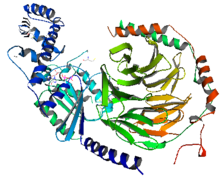| Heterotrimeric G-protein GTPase | |||||||||
|---|---|---|---|---|---|---|---|---|---|
| Identifiers | |||||||||
| EC no. | 3.6.5.1 | ||||||||
| CAS no. | 9059-32-9 | ||||||||
| Databases | |||||||||
| IntEnz | IntEnz view | ||||||||
| BRENDA | BRENDA entry | ||||||||
| ExPASy | NiceZyme view | ||||||||
| KEGG | KEGG entry | ||||||||
| MetaCyc | metabolic pathway | ||||||||
| PRIAM | profile | ||||||||
| PDB structures | RCSB PDB PDBe PDBsum | ||||||||
| Gene Ontology | AmiGO / QuickGO | ||||||||
| |||||||||


Heterotrimeric G protein, also sometimes referred to as the "large" G proteins (as opposed to the subclass of smaller, monomeric small GTPases) are membrane-associated G proteins that form a heterotrimeric complex. The biggest non-structural difference between heterotrimeric and monomeric G protein is that heterotrimeric proteins bind to their cell-surface receptors, called G protein-coupled receptors (GPCR), directly. These G proteins are made up of alpha (α), beta (β) and gamma (γ) subunits.[1] The alpha subunit is attached to either a GTP or GDP, which serves as an on-off switch for the activation of G-protein.
When ligands bind a GPCR, the GPCR acquires GEF (guanine nucleotide exchange factor) ability, which activates the G-protein by exchanging the GDP on the alpha subunit to GTP. The binding of GTP to the alpha subunit results in a structural change and its dissociation from the rest of the G-protein. Generally, the alpha subunit binds membrane-bound effector proteins for the downstream signaling cascade, but the beta-gamma complex can carry out this function also. G-proteins are involved in pathways such as the cAMP/PKA pathway, ion channels, MAPK, PI3K.
There are four main families of G proteins: Gi/Go, Gq, Gs, and G12/13.[2]
- ^ Hurowitz EH, Melnyk JM, Chen YJ, Kouros-Mehr H, Simon MI, Shizuya H (April 2000). "Genomic characterization of the human heterotrimeric G protein alpha, beta, and gamma subunit genes". DNA Research. 7 (2): 111–20. doi:10.1093/dnares/7.2.111. PMID 10819326.
- ^ Nature Reviews Drug Discovery GPCR Questionnaire Participants (July 2004). "The state of GPCR research in 2004". Nature Reviews. Drug Discovery. 3 (7) (3 ed.): 575, 577–626. doi:10.1038/nrd1458. PMID 15272499. S2CID 33620092.